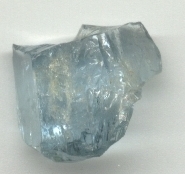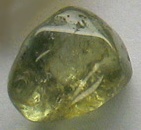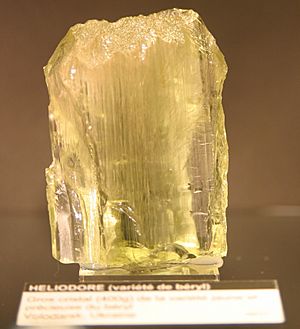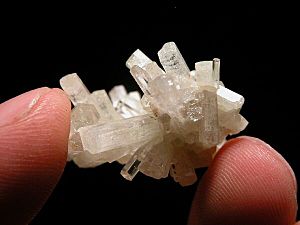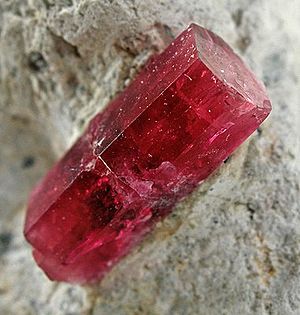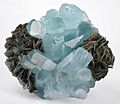Beryl facts for kids
Quick facts for kids Beryl |
|
|---|---|
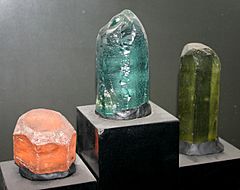
Three varieties of beryl: morganite, aquamarine and heliodor
|
|
| General | |
| Category | Silicate mineral |
| Crystal symmetry | (6/m 2/m 2/m) – Dihexagonal Dipyramidal |
| Identification | |
| Formula mass | 537.50 |
| Color | Green, Blue, Yellow, Colorless, Pink & others. |
| Crystal habit | Massive to well Crystalline |
| Crystal system | Hexagonal (6/m 2/m 2/m) Space Group: P 6/mсc |
| Cleavage | Imperfect on the [0001] |
| Fracture | Conchoidal |
| Luster | Vitreous |
| Streak | White |
| Diaphaneity | Transparent to opaque |
| Specific gravity | Average 2.76 |
| Ultraviolet fluorescence | None (some fracture filling materials used to improve emerald's clarity do fluoresce, but the stone itself does not) |
Beryl is a cool mineral that's part of the silicate family. It's also where we get the metal beryllium from. Sometimes, beryl grows into super big crystals! Some have been found as long as 18 meters (about 59 feet).
Many colorful types of beryl are used to make beautiful jewelry. These include green emeralds, blue-green aquamarines, red bixbite, pink morganite, and golden heliodor.
Contents
What Are the Different Types of Beryl?
Beryl comes in many amazing colors. Each color has its own special name. Let's explore some of the most famous types of beryl.
Aquamarine: The Color of the Sea
Aquamarine gets its name from Latin words meaning "water of the sea." It's a beautiful blue or turquoise kind of beryl. You can find aquamarine in many places where regular beryl grows. Some of the best ones come from Russia.
Tiny pieces of aquamarine are also found in riverbeds in Sri Lanka. A clear yellow beryl from Brazil is sometimes called "aquamarine chrysolite."
Maxixe: A Deep Blue Aquamarine
A very deep blue aquamarine is called maxixe. But watch out! Its color can fade to white if it's left in sunlight or gets too hot. Luckily, the color can come back with special treatment.
Where to Find Aquamarine
In the United States, you can find aquamarines at the top of Mount Antero in Colorado. They've also been found in the Bighorn Mountains in Wyoming.
Brazil has many mines for aquamarine in states like Minas Gerais and Espírito Santo. Other countries that produce aquamarine include Colombia, Zambia, Madagascar, and Kenya.
The Biggest Aquamarine Ever
The largest aquamarine gemstone ever found was in Brazil in 1910. It weighed over 110 kilograms (about 242 pounds)! It was 48.5 centimeters (about 19 inches) long and 42 centimeters (about 16.5 inches) wide. Imagine a crystal that big!
Emerald: The Famous Green Gem
Emerald is the green type of beryl. Its green color comes from tiny bits of chromium and sometimes vanadium inside the stone.
Emeralds Through History
People have mined emeralds for a very long time. The Egyptians and people in Austria mined them in ancient times. They were also found in Swat in northern Pakistan.
Trapiche Emeralds
A special kind of emerald, called a trapiche emerald, is sometimes found in Colombia. This emerald has a cool "star" pattern. It looks like dark lines of carbon impurities spread out from the center, making a six-pointed star. It's named after a trapiche, which is a grinding wheel used for sugarcane.
Where Emeralds Are Found Today
Colombian emeralds are often the most valued because they are so clear and sparkly. The best ones come from three main mining areas in Colombia: Muzo, Coscuez, and Chivor.
You can also find beautiful emeralds in Zambia, Brazil, Zimbabwe, Madagascar, Pakistan, India, Afghanistan, and Russia. In the US, emeralds are found in Hiddenite, North Carolina. In 1998, emeralds were even discovered in the Yukon in Canada.
Golden Beryl and Heliodor: Sunny Gems
Golden beryl can be anything from a light yellow to a bright, shiny gold. Unlike emeralds, golden beryl usually has very few flaws. Both golden beryl and heliodor are popular gemstones.
One of the largest cut golden beryls is a huge, perfect stone that weighs 2054 carats. You can see it on display in the Hall of Gems in Washington, D.C..
Goshenite: The Clear Beryl
Colorless beryl is called goshenite. It got its name from Goshen, Massachusetts, where it was first found.
You can find goshenite in most places where beryl is found. Long ago, people used goshenite to make eyeglasses and lenses because it was so clear. Today, it's mostly used as a gemstone. It's also a source for the metal beryllium.
Goshenite isn't as valuable as some other gems. However, it can be changed into yellow, green, pink, or blue colors by treating it with high-energy particles. The final color depends on the tiny amounts of other elements inside the stone.
Morganite: The Pink Beryl
Morganite is also known as "pink beryl" or "pink emerald." It's a rare and beautiful light pink to rose-colored gem. Sometimes, you can find orange or yellow morganite too.
Morganite can be heated to remove yellow spots and sometimes treated to make its pink color even better. The pink color comes from tiny amounts of manganese inside the crystal.
Discovery of Morganite
Pink beryl was first found on an island off the coast of Madagascar in 1910. It was also discovered in Pala, California, along with other gems like tourmaline. In December 1910, a group of scientists named this pink beryl "morganite" after a famous banker, J. P. Morgan.
Red Beryl: A Very Rare Gem
Red beryl is a very rare red type of beryl. It's also called "red emerald" or "scarlet emerald." It was first described in 1904 in Utah, USA. The old name "bixbite" is not used anymore because it sounds too much like another mineral called bixbyite. The dark red color comes from manganese.
Red beryl is super rare and has only been found in a few places. Most of the best gem-quality red beryl comes from the Violet Claim in the Wah Wah Mountains of Utah. A person named Lamar Hodges found it in 1958 while looking for uranium.
Images for kids
See also
 In Spanish: Berilo para niños
In Spanish: Berilo para niños


